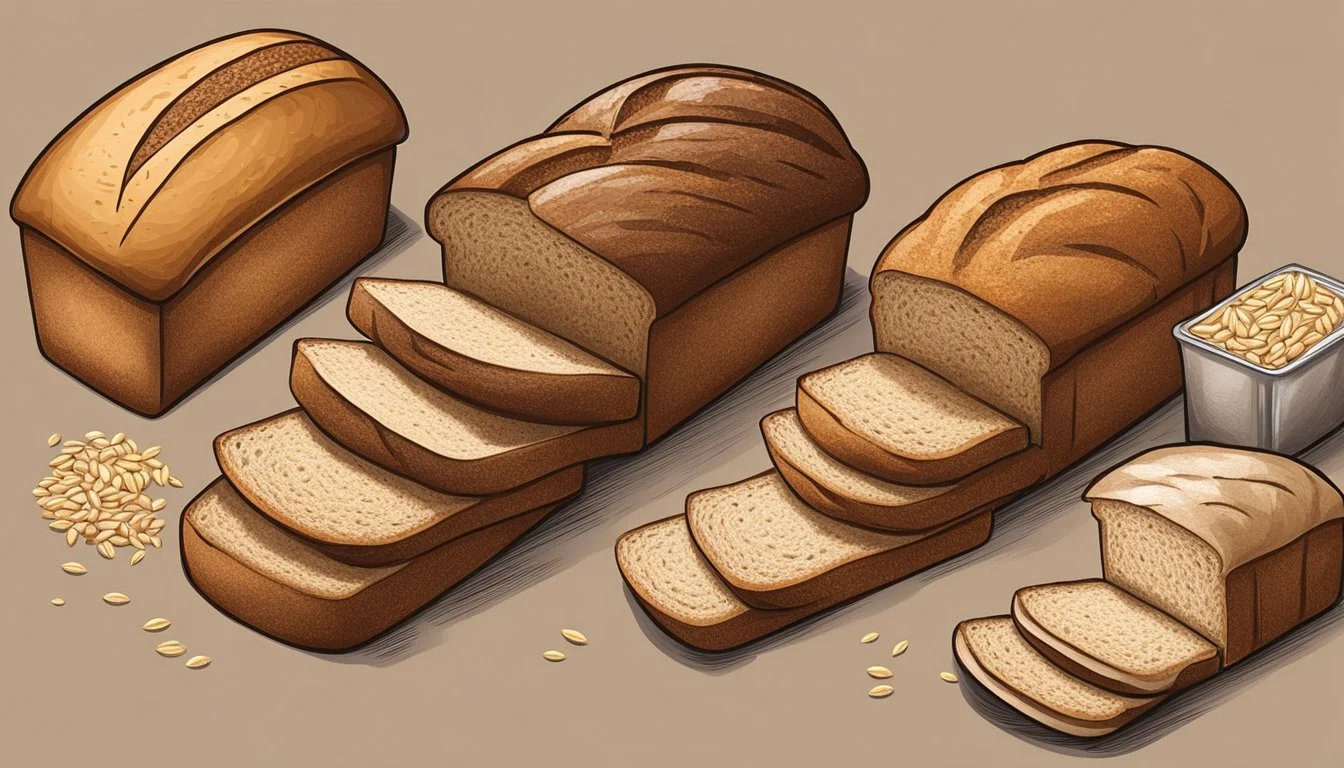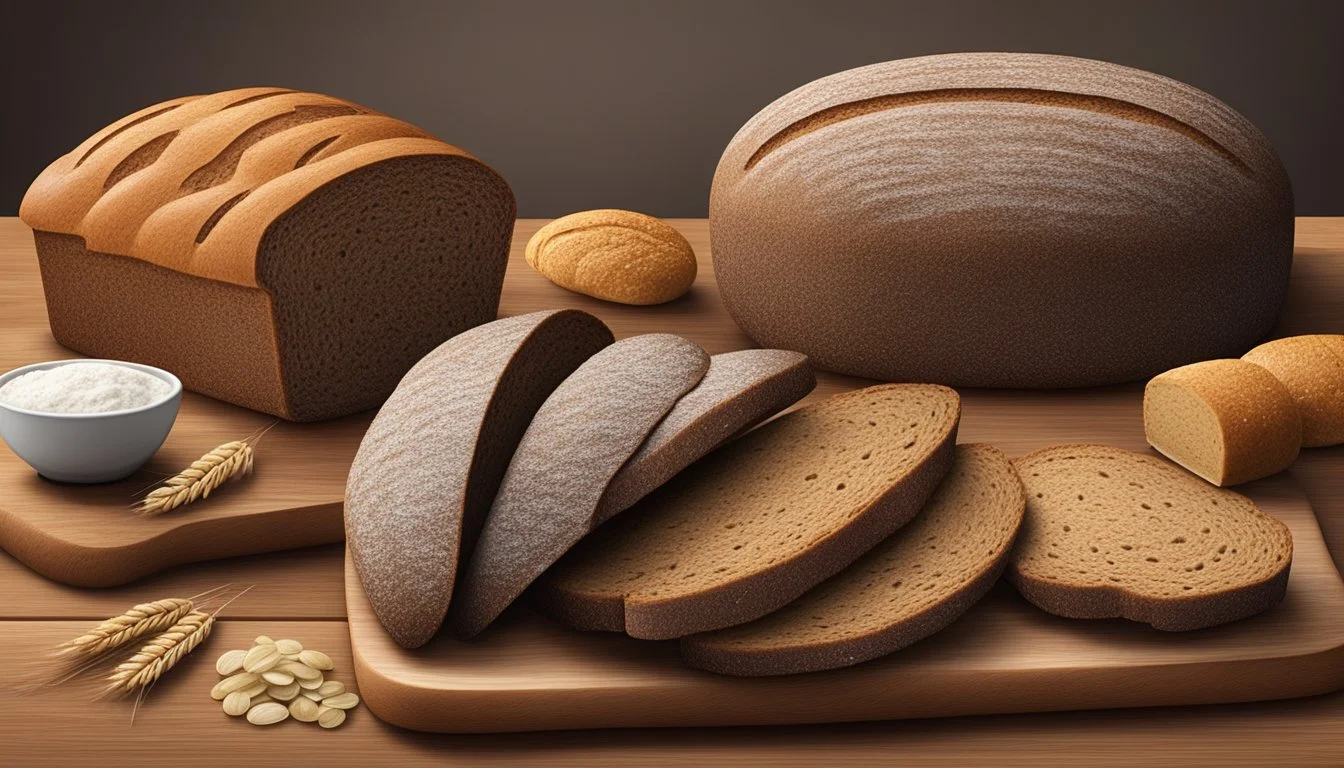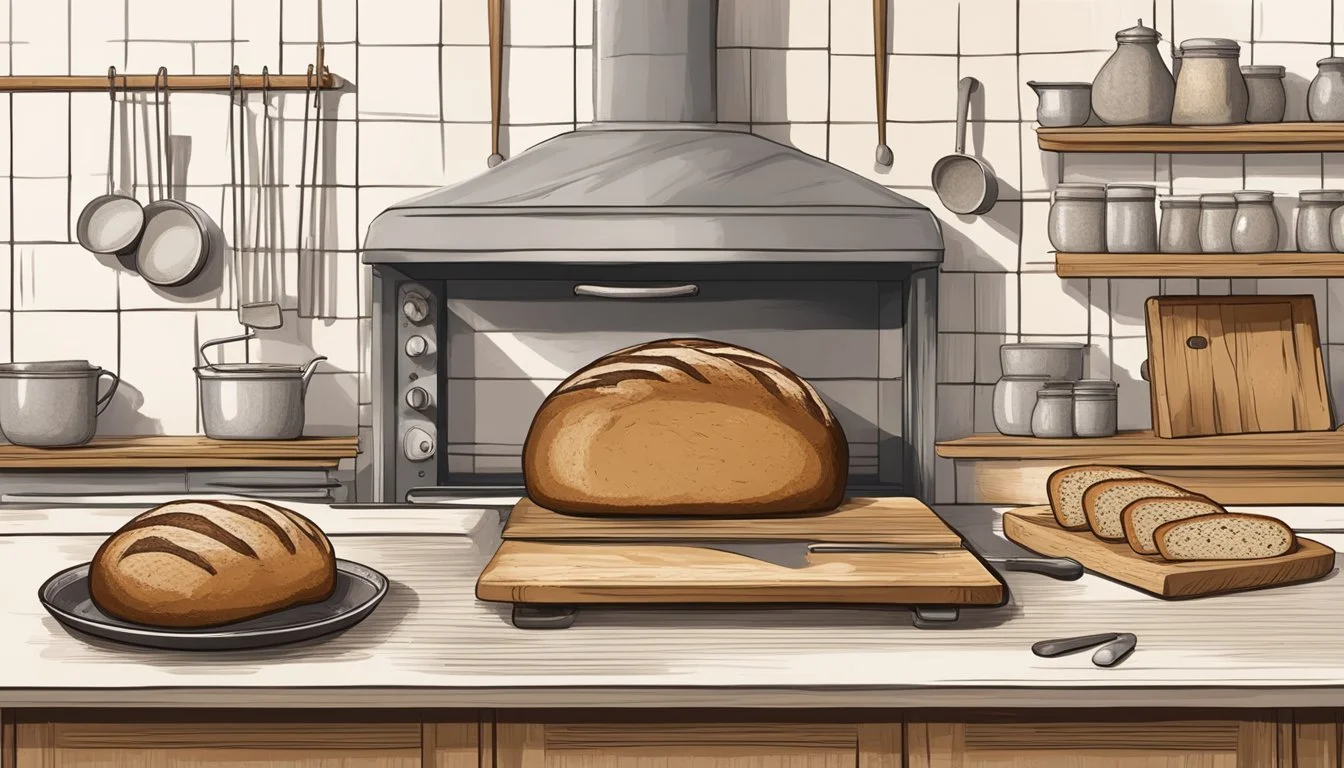Rye Bread Substitutes
Top Alternatives for Your Diet
Rye bread is cherished for its distinctive flavor and nutritional benefits, often identified by its slightly sour taste and dense, chewy texture. It's made from rye flour which contains less gluten than wheat, resulting in a tighter crumb. Rye is rich in dietary fiber and has been a staple in many cultures, notably within Eastern European and Scandinavian cuisines. While rye bread has its enthusiasts, some may seek alternatives due to dietary restrictions, flavor preferences, or simply out of curiosity to try something new.
Substitutes for rye bread can be selected based on how closely they mimic the original's taste, texture, and nutritional profile. Breads like pumpernickel, which is made from a mix of rye flour and whole rye grains, offer a similar flavor complexity and dense texture, making it one of the closest stand-ins for rye. Whole grain breads, such as those made with spelt or barley, and sourdough variations provide healthful options while maintaining a hearty flavor.
When contemplating substitutes for rye bread, it's essential to consider the purpose it serves in a meal. For sandwiches or toast, where the bread's structural integrity is important, options like multigrain or whole wheat breads could be suitable due to their robust texture and ability to hold toppings or fillings. Exploring rye bread alternatives is not only a solution when facing its scarcity but also provides an opportunity to diversify one's diet with breads that offer varying tastes and nutritional benefits.
Understanding Rye Bread
Rye bread is distinguished by its unique flavor and texture, and it serves as an integral part of various cultural cuisines. It is celebrated not only for its distinct taste but also for its nutritional advantages.
Characteristics of Rye Bread
Rye bread is made primarily with rye flour, which comes from the rye grain, a close relative of wheat. Unlike white bread made from refined wheat flour, rye bread often retains more of the whole grain, resulting in a denser texture. The flavor profile of rye bread is typically described as slightly sour and earthy, often referred to as a nutty flavor. This distinctive taste is what sets rye bread apart from other bread varieties.
The texture of rye bread is also key to its character. It is usually denser and firmer than bread made with wheat flour, leading to a more satisfying chew. This density can be attributed to the lower gluten content in rye flour as compared to wheat flour. Gluten is the protein that gives dough its elasticity and rise. Since rye contains less gluten, breads made with rye flour don't rise as much as their wheat counterparts, resulting in a compact crumb.
Nutritional Profile of Rye
Rye bread is nutritionally rich, offering a variety of nutrients beneficial to a balanced diet. It typically contains a higher fiber content than white bread, making it a good choice for digestive health. The fiber in rye can aid in regulating blood sugar levels and promoting a feeling of fullness.
Aside from fiber, rye bread also provides protein, essential for muscle repair and growth. It's a source of various vitamins and minerals such as:
Iron, necessary for the transportation of oxygen in the blood
B vitamins, aiding in energy metabolism and nervous system function
Magnesium, important for muscle and nerve function as well as bone health
Rye bread also contains an array of other minerals and nutrients, contributing to its overall nutritional profile, which is why many health-conscious individuals often include rye bread in their diet.
Reasons for Substituting Rye Bread
Some people choose to substitute rye bread due to health-related concerns or personal dietary choices. This section explores the primary factors motivating individuals to seek alternatives.
Gluten Sensitivities and Allergies
For those with gluten sensitivities or celiac disease, consuming rye bread can lead to adverse health effects because it contains gluten. Gluten-free breads offer a safe alternative, allowing these individuals to enjoy bread without the associated risks. Gluten-free options are often made from various flours like rice, almond, and buckwheat, which do not contain gluten.
Dietary Preferences and Varieties
Aside from health reasons, individuals may opt for substitutes to introduce variety into their diet or as a personal preference. Some might seek a healthier option with different nutritional benefits, such as increased fiber or protein content found in legume flours such as chickpea and lentil flour. Others may simply prefer the taste or texture of alternatives, ranging from the sweetness of honey flaxseed bread to the nuttiness of whole wheat variants.
Types of Rye Bread Substitutes
When looking for a rye bread alternative, consumers often seek options that cater to dietary needs or provide a richer nutrient profile. The substitutes below are categorized into gluten-free alternatives for those with sensitivities and nutrient-dense options for health-conscious consumers.
Gluten-Free Bread Alternatives
Gluten-Free Bread provides a viable substitute for rye bread, particularly for those with gluten intolerance or celiac disease. These breads are typically made from flours that do not contain gluten, such as rice, almond, buckwheat, chickpea, sorghum, and millet. They offer a similar density and can often mimic the texture of traditional rye bread, making them suitable for sandwiches and toast.
Common Gluten-Free Breads:
Rice bread
Almond bread
Buckwheat bread
Chickpea bread
Sorghum bread
Millet bread
Nutrient-Dense Substitutes
Substitutes such as Sprouted Bread, Pumpernickel, and Ezekiel Bread are considered nutrient-dense alternatives to rye bread. They are often higher in protein and fiber due to the whole grains and sprouts used in their production.
Sprouted Bread is made from whole grains that have started to sprout, increasing their nutrient value. It can include sprouted grains like millet, barley, and even rye itself.
Pumpernickel Bread is a dense and hearty option, made with coarsely ground rye grain and often rye sourdough starter. It has a deep, rich flavor and maintains a high fiber content.
Ezekiel Bread is a type of sprouted bread, typically made from a mix of six grains and legumes that have been sprouted to increase nutrient availability. It often includes wheat, millet, barley, and spelt.
Additional Nutrient-Dense Options:
Whole wheat bread
Multigrain bread
Choosing the right substitute depends on personal dietary needs and flavor preferences. Both gluten-free and nutrient-dense substitutes provide a range of options for those looking to switch from rye bread while maintaining a balanced diet.
Comparing Flavors and Textures
When considering alternatives to rye bread, one should assess the flavor and texture of potential substitutes, as these characteristics significantly influence the overall eating experience.
Similar Flavors to Rye Bread
Rye bread is known for its earthy and tangy flavor profile. Substitutes that offer a similar taste include:
Pumpernickel Bread: It shares the robust, earthy flavor characteristic of rye but has a slightly sweeter note.
Sourdough Bread: Known for its tangy flavor, which can mimic the distinct sourness found in rye bread.
Texture Variations in Substitutes
While rye bread typically has a dense and chewy texture, substitutes can vary in their textural attributes:
Substitute Bread Texture Description Whole Wheat Bread Usually has a firm texture, but not as dense as rye. Multigrain Bread Offers a robust chew similar to rye with added crunch from various grains. Honey Flaxseed Bread Light and slightly crunchy with a softer chew than rye.
Breads with a crunchy texture and nutty flavor, such as honey flaxseed bread, can also be pleasant substitutes for those who enjoy a lighter bread yet still seek some textural resemblance to rye.
Alternative Grains and Flours
Exploring alternative grains and flours can offer diverse flavors and textures in baking, along with a range of nutritional profiles. Some are suitable for those avoiding gluten, while others provide a boost of nutrients.
Gluten-Free Grains
For those seeking gluten-free substitutes for rye bread, several grains offer wonderful alternatives that cater to dietary restrictions without compromising on taste:
Oats: Oat flour is a versatile option, best when blended with other flours to enhance texture and flavor.
Buckwheat: Despite its name, buckwheat is gluten-free and has a rich flavor. Buckwheat flour works well for hearty breads.
Sorghum: Sorghum flour is a popular gluten-free alternative, known for its mild taste and smooth texture.
Nutrient-Rich Flour Options
Seeking nutrient density in baking leads to flours that are both flavorful and healthful. These flours are often used in combination with others to achieve the best results:
Spelt Flour: Spelt offers a sweet, nutty taste and is high in protein and fiber. While it contains gluten, it's an enriching alternative for those not constrained by a gluten-free diet.
Almond Flour: Rich in protein and healthy fats, almond flour adds moisture and a pleasant texture to baked goods.
Barley: While barley contains gluten, it's a wholesome choice that imparts a chewy texture and fiber boost.
By considering these grain and flour alternatives, bakers can enjoy a broad spectrum of flavors, textures, and nutritional benefits.
Bread Baking Alternatives
When seeking out substitutes for rye bread, a baker has two primary avenues: creating a homemade version that mimics the unique qualities of rye or opting for a commercial product with similar characteristics.
Homemade Rye Bread Substitutes
For those who delight in the craft of baking, homemade bread offers an opportunity to experiment with a range of flavors and textures. When rye flour is not an option, alternatives include:
Wheat Bread: Wheat flour provides a sturdy structure due to its gluten content, making it a reliable base for bread. Incorporating whole wheat flour can add a robust, nutty flavor akin to rye. To further mimic rye's essence, a homemade bread might employ:
Sourdough Starter: A robust sourdough starter can introduce the tanginess often associated with rye bread. The long fermentation process enhances flavor and aids digestion.
Commercial Yeast: Quick-rising commercial yeast can be used as the leavening agent for a faster bake, though it may lack the depth of a sourdough.
Commercial Baking Alternatives
When time or skill constraints direct one towards ready-made options, numerous commercial alternatives can stand in for rye bread:
Sprouted Bread: It boasts a blend of grains, such as oats, barley, and millet, resulting in a nutrient-rich profile.
Honey Flaxseed Bread: With a sweet and nutty flavor, this bread provides a distinct, yet pleasant contrast to rye's earthy tone.
Gluten-Free Bread: Varied blends of rice, buckwheat, and chickpea flours yield gluten-free options that still offer textural integrity.
All these alternatives keep the home baker or shopper within the realm of rye bread's distinctive experience while offering their unique merits.
Customizing Substitutes for Rye Bread
When searching for alternatives to rye bread, one can maintain the bread's characteristic taste and texture through the careful inclusion of seeds and nuts, as well as the addition of fruits and sweeteners for a customized flavor profile.
Incorporating Seeds and Nuts
Seeds are essential in replicating the taste and texture of rye bread. Flax seeds and caraway seeds are commonly used to create a nutty and slightly spicy flavor reminiscent of rye. Bakers might consider a honey flaxseed bread for its sweet, nutty flavor and light, crunchy texture. By adding seeds, one also benefits from an increase in dietary fiber and healthy fats.
To incorporate nuts, a whole grain walnut bread can offer a dense and satisfying substitute. Walnuts not only add a rich, earthy taste but also contribute beneficial omega-3 fatty acids.
Seeds to Consider:
Flax seeds
Caraway seeds
Nut-Enriched Bread Examples:
Whole grain walnut bread
Enhancing Bread with Fruits and Sweeteners
For a sweeter take on rye substitute, bakers can experiment with dried fruits like dates, giving rise to bread options like whole grain walnut and date bread. Fruits add natural sweetness and moisture, allowing the bread to stay fresh longer.
In terms of sweeteners, honey or molasses can be employed to provide a subtle sweetness while also contributing to a moist crumb and a tender crust. These sweeteners can complement the robust flavors of the seeds and nuts.
Sweet Additions:
Honey: Adds mild sweetness and helps in achieving a tender crust.
Molasses: Provides deep, rich sweetness and a soft crumb.
Remember, bakers should adjust quantities according to their taste preferences and the specific attributes they wish to mimic from rye bread.
Pairings and Uses for Substitutes
When selecting a substitute for rye bread, it's important to consider how the alternative complements both savory and sweet toppings. The texture and flavor profile of the substitute bread can significantly influence the final taste of your dish.
Savory Pairings
One can readily pair honey flaxseed bread with savory ingredients due to its slightly sweet and nutty flavor. It acts as an excellent base for sandwiches and can be elevated with the following combinations:
Cheese: Aged cheddar or Swiss cheese complements the bread’s crunchy texture.
Mustard: A spread of Dijon mustard adds a tangy zest, balancing the bread's inherent sweetness.
Olive Oil: Brushing a slice with olive oil before toasting enhances its nuttiness.
Smoked Salmon: Top with slices of smoked salmon for a refined contrast of flavors.
Sweet and Versatile Combinations
For those with a sweeter palate, sprouted bread serves as a nutritious and fiber-rich replacement for rye bread. Its versatility is highlighted in these pairings:
Butter: A classic spreading of butter on warm sprouted bread makes for a gently sweet and satisfying snack.
Jam: A dollop of raspberry or blackberry jam pairs perfectly with the subtle earthiness of the sprouted grains.
Soup: This bread can also be served alongside a bowl of hearty soup for a wholesome meal.
Health and Nutritional Considerations
When considering substitutes for rye bread, one must examine their impact on blood sugar levels and the nutritional content. Specifically, it is crucial to understand the glycemic index of different breads and the vitamins and minerals they contain.
Impact on Blood Sugar and Glycemic Index
The glycemic index (GI) is a critical factor for managing blood sugar levels and may influence one's choice of rye bread substitutes. Foods with a lower glycemic index are typically better for maintaining stable blood sugar levels. Legume flours, such as chickpea and lentil flour, have a lower GI, which can be beneficial for those monitoring their blood sugar. On the other hand, breads like honey flaxseed bread may have a slightly higher GI due to their sweetness, but the presence of fiber can mitigate rapid spikes in blood sugar levels.
Vitamins and Mineral Content
Rye bread is known for its nutritious value, offering a decent amount of fiber, magnesium, and vitamin B6. Substitutes should ideally match these nutritional benefits. For example, sprouted bread tends to be high in vitamins and minerals as sprouting increases nutrient availability. Here’s a comparison of nutrient content in various substitutes:
Chickpea Flour: High fiber content and an additional boost of protein.
Honey Flaxseed Bread: Contains omega-3 fatty acids from flaxseeds and may have added nutrients depending on the flour blend.
Sprouted Bread: Generally higher in protein and nutrients, sprouted grains enhance the presence of essential vitamins and minerals, including vitamin B6 and magnesium.
In selecting a rye substitute, examining both the glycemic index and the nutritional profile ensures a choice that aligns with one's health goals and dietary needs.
Cultural and Regional Variations
Rye has played a significant role in the cultural heritage of Europe, where it has been used for centuries. As a robust grain, it has shaped regional food traditions and is deeply embedded in a variety of culinary practices.
Rye and Its Historical Uses in Europe
In Europe, rye has been a staple grain since the Middle Ages, particularly in the northeastern and central parts of the continent where the climate is conducive to its growth. The grain's resilience to cold weather and poor soil conditions cemented its place in agricultural and culinary histories.
Germany: Known for its substantial rye breads, like pumpernickel, a dense and dark bread favored for its earthy flavors.
Scandinavia: Here, rye is used in making knäckebröd, a crispbread that is part of the staple diet and enjoyed for its long shelf-life.
These historical uses of rye reflect the diverse climatic and cultural landscapes where rye grain thrives and provides sustenance.
Bread Varieties Across the Globe
The use of rye in breadmaking is not limited to Europe, though it remains at the heart of many European breads. Globally, various regions have their specialties when it comes to bread, shaped by the type of grains available and culinary preferences.
Middle East: Flatbreads like pita are prevalent, often made from wheat, that offer versatility in regional cuisine.
Asia: Steamed buns and rice flour breads reflect the predominant use of rice as a staple grain.
These breads, while distinct from European rye breads, underscore the universal importance of bread in diets across the world, each region bringing its unique twist to this common food staple.









